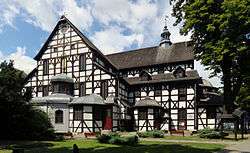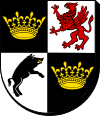Świdnica
| Świdnica | ||
|---|---|---|
|
Old town | ||
| ||
 Świdnica | ||
| Coordinates: 50°51′N 16°29′E / 50.850°N 16.483°ECoordinates: 50°51′N 16°29′E / 50.850°N 16.483°E | ||
| Country |
| |
| Voivodeship | Lower Silesian | |
| County | Świdnica County | |
| Gmina | Świdnica (urban gmina) | |
| City rights | 1267 | |
| Government | ||
| • President | Beata Moskal-Słaniewska (SLD) | |
| Area | ||
| • Total | 21.76 km2 (8.40 sq mi) | |
| Elevation | 250 m (820 ft) | |
| Population (2014) | ||
| • Total | 59,002 | |
| • Density | 2,700/km2 (7,000/sq mi) | |
| Time zone | CET (UTC+1) | |
| • Summer (DST) | CEST (UTC+2) | |
| Postal code | 58-100 to 58-106 | |
| Area code(s) | +48 74 | |
| Car plates | DSW | |
| Website | http://www.um.swidnica.pl | |
Świdnica (Polish pronunciation: ['ɕfʲidʲˈɲit͡sa]; German: Schweidnitz; Czech: Svídnice) is a city in south-western Poland in the region of Silesia. It has a population of 59,002 inhabitants according to 2014 figures. It lies in Lower Silesian Voivodeship, being the seventh largest town in that voivodeship. From 1975–98 it was in the former Wałbrzych Voivodeship. It is now the seat of Świdnica County, and also of the smaller district of Gmina Świdnica (although it is not part of the territory of the latter, as the town forms a separate urban gmina). Świdnica became part of the Wałbrzych agglomeration on 23 January 2014.[1]
History

Świdnica/Schweidnitz became a town in 1250, although no founding document has survived that would confirm this fact. In the beginning, the town belonged to the Duchy of Breslau (now Wrocław). By 1290, the town had city walls and six gates, crafts and trade were blossoming, and in 1291-1392 it was the capital of the Duchy of Schweidnitz.
At the end of the 14th century the city was under rule of the Kingdom of Bohemia, and a long period of growth began. The last Polish Piast duke was Bolko II of Świdnica, and after his death in 1368 the duchy was held by his wife until 1392; after her death it was incorporated into Bohemia by Wenceslaus IV, king of Bohemia and later Holy Roman Emperor. In 1493, the town is recorded by Hartmann Schedel in his Nuremberg Chronicle as Schwednitz[2]
In 1526, all of Silesia, including Świdnica, came under the rule of the Habsburg Monarchy. The city was in the surrounding Duchy of Schweidnitz. The Thirty Years' War (1618–48) ravaged the Duchy. Świdnica was annexed by the Kingdom of Prussia during the First Silesian War (1740–42). It was subsequently turned into a fortress by Frederick II of Prussia's army.
It was captured again by Austria in late 1762, during the Third Silesian War, or Seven Years' War, but remained Prussian after the end of the war. Subsequently, it became part of the Prussian-led German Empire in 1871 during the unification of Germany and stayed within Germany until the end of World War II.
After the defeat of Nazi Germany in 1945, the town, like most of Silesia, became part of Poland under border changes promulgated at the Potsdam Conference, and was officially renamed Świdnica. Those members of the German population who had not fled or been killed during the war were subsequently expelled to Germany and replaced with Poles, many of whom had themselves been expelled from Polish areas annexed by the Soviet Union.
Points of interest

The Gothic Church of Ss. Stanislav and Vaclav from the 14th century has the highest tower in Silesia, standing 103 meters tall. The Evangelical Church of Peace, a UNESCO Heritage site, was built from 1656–57. The 16th-century town hall has been renovated numerous times and combines Gothic, Renaissance, and Baroque architectural elements. The Baroque Church of St. Joseph and the Church of St. Christopher are from the same era. One remaining element of the former defensive works is the Chapel of St. Barbara.
Other notable destinations include the old town and the Stary Rynek square, Gola Dzierżoniowska Castle, Medieval town of Niemcza, Cistercian monastery at Henryków and the Wojsławice Arboretum.
Politics
Wałbrzych constituency
Members of Parliament (Sejm) elected from Wałbrzych constituency, (Wałbrzych)
- Zbigniew Chlebowski, PO
- Henryk Gołębiewski, SLD
- Roman Ludwiczuk, PO (Senat)
- Katarzyna Mrzygłocka, PO
- Giovanni Roman, PiS
- Mieczysław Szyszka, PiS (Senat)
- Anna Zalewska, PiS
Education
Świdnica is home to a College of Data Communications Technology (Wyższa Szkoła Technologii Teleinformatycznych).
In 2003, Świdnica hosted a session of the Warsaw-based International Chapter of the Order of Smile, when a Child Friendship Centre was established. Świdnica was officially titled the "Capital of Children's Dreams".
Sport
- Polonia/Sparta Świdnica - football club
International relations
Twin towns — Sister cities
Świdnica is twinned with:
-
 Ivano-Frankivsk, Ukraine[3]
Ivano-Frankivsk, Ukraine[3] -
.svg.png) Maldegem, Belgium
Maldegem, Belgium -
 Jičín, Czech Republic [4]
Jičín, Czech Republic [4] -
 Police nad Metují, Czech Republic
Police nad Metují, Czech Republic -
 Trutnov, Czech Republic
Trutnov, Czech Republic -
 Švenčionys district municipality, Lithuania
Švenčionys district municipality, Lithuania -
 Biberach, Germany
Biberach, Germany -
 Tendring District, United Kingdom
Tendring District, United Kingdom
Notable residents
- Thomas Stoltzer (ca. 1480-1526), composer
- Maria Cunitz (1604–1664), astronomer
- Benjamin Schmolk (1672–1737), composer, poet
- Johann Christoph Glaubitz (c. 1700-1767 in Vilnius) architect
- Johann Gottlieb Janitsch (1708–1763), composer
- Emil Krebs (1867–1930), sinologist
- Ferdinand Friedensburg (1886–1972), politician
- Michael Graf von Matuschka (1888–1944), resistance fighter
- Hubert Schmundt (1888–1984), Kriegsmarine Admiral
- Manfred von Richthofen (1892–1918), World War I ace known as "The Red Baron"
- Peter Adolf Thiessen (1899–1990), physical chemist
- Heinz Starke (1911–2001), politician, Bundesfinanzminister 1961-1962
- Georg Gärtner (1920–2013), known as "Hitler's last Soldier in America"
- Gunther Gebel-Williams (1934–2001), animal trainer
- Manfred Kanther (born 1939), politician
- Henning Eichberg (born 1942), cultural sociologist
- Bartosz Huzarski (born 1980), cyclist
- Arkadiusz Piech (born 1985), footballer
- Anna Werblińska (born 1984), volleyball player
Notes
References
- ↑ Press release, Siedem nowych gmin w Aglomeracji Wałbrzyskiej. Swidnica24.pl. Retrieved 23 February 2014.
- ↑ See Die Schedelsche Weltchronik on German Wikisource.
- ↑ Офіційний сайт міста Івано-Франківська. mvk.if.ua (in Ukrainian). Retrieved 7 March 2010.
- ↑ "Partnerská města: Jičín".
External links
| Wikivoyage has a travel guide for Świdnica. |
- Silesia Map of 1600s with Town of Schweidnitz in Duchy of Schweidnitz
- Website of the municipality of Świdnica
- Jewish Community in Świdnica on Virtual Shtetl
- Peace Church Panoramic view
![]() Media related to Świdnica at Wikimedia Commons
Media related to Świdnica at Wikimedia Commons
-
 Chisholm, Hugh, ed. (1911). "Schweidnitz". Encyclopædia Britannica (11th ed.). Cambridge University Press.
Chisholm, Hugh, ed. (1911). "Schweidnitz". Encyclopædia Britannica (11th ed.). Cambridge University Press.

_COA.svg.png)